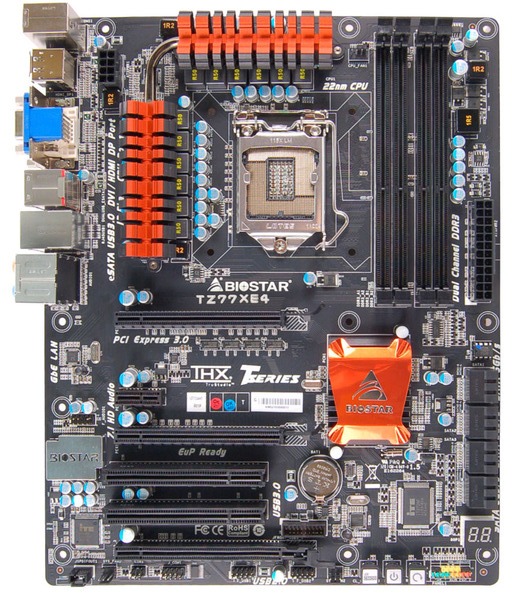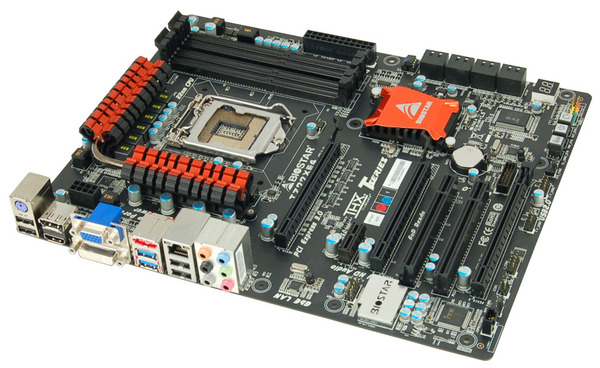Intel Z77 Panther Point Chipset and Motherboard Preview – ASRock, ASUS, Gigabyte, MSI, ECS and Biostar
by Ian Cutress on April 8, 2012 12:00 AM EST- Posted in
- Motherboards
- Intel
- Biostar
- MSI
- Gigabyte
- ASRock
- Asus
- Ivy Bridge
- ECS
- Z77
Biostar TZ77XE4—Visual Inspection
With memories of Biostar fresh in my mind from the 990FX roundup, I have another chance to tackle a motherboard from them. This one comes in at more of a premium than the other—at an MSRP of $169 it is not the cheapest board this time. However, it does seem to have learned some lessons with the PCIe layout at least, but in terms of features we are perhaps a bit lacking.
Biostar have characteristically been black and orange, and we see it here again on their top Z77 model, the TZ77XE4. Power delivery is essentially a 10+2 (CPU/iGPU) system with large brightly colored heatsinks to remove heat, both connected via a heatpipe. These heatsinks are set a little away from the Intel designated socket area, though the memory banks are right up against the boundary—with only two sticks of memory in the board there will be enough room for most of the beefiest air coolers.
In terms of fan headers, Biostar have unfortunately put much effort in here, with only three to play with—a 4-pin CPU fan header to the top right of the socket, and two 3-pin at the south end of the board. Anyone requiring headers for fans will have to resort to providing their own fan control.

Along the right hand side, apart from the 24-pin power connector, we have a series of eight SATA ports—two SATA 6 Gbps from the PCH, four SATA 3 Gbps also from the PCH, and another two SATA 6 Gbps from an ASMedia controller. These are unfortunately not color coded, meaning users will have to double check every time that the SATA cable is going into the port as intended. Below these, we have a two-digit debug display for error reporting.
The chipset heatsink sports the bright orange Biostar color, but is rather small which could lead to it being warm to the touch. On the south side of the board, we are not exactly bursting with headers—aside from the fans, we have front panel headers, a pair of USB 2.0 headers, and power/reset/clear CMOS buttons. These buttons are all similar and next to each other, so I can just see myself accidentally pressing the wrong one from time to time. It is also important to note the location of a USB 3.0 header, just above the third full-length PCIe slot. This is a rather awkward place, and cements its use primarily for rear facing adaptors (as long as there is nothing in the PCI slot beside it).

The PCIe layout is better than previous iterations, featuring an x16 (x8 in dual-GPU), x1, x8, PCI, PCI and Gen 2.0 x4. This leaves a space between GPUs, and a spare x1, PCI and x4 when dual GPUs are being used. Note we do not have a molex connector here, suggesting that Biostar are happy with the power delivery when the PCIe slots are in use.

For back panel functionality, we have a PS2 keyboard port, two USB 2.0 ports (black), DisplayPort, HDMI, D-Sub, DVI-I, eSATA, two USB 3.0 (blue), gigabit Ethernet, two more USB 2.0 (black), and audio jacks. I should stress that even though there is a DVI-I on the back panel, it does not accept analog signals by adaptor.
Board Features
| Biostar TZ77XE4 | |
| Size | ATX |
| CPU Interface | LGA-1155 |
| Chipset | Intel Z77 |
| Power Delivery | 10 + 2 + 1 + 2 (CPU/GPU/VCCIO/Memory) |
| Memory Slots |
Four DDR3 DIMM slots supporting up to 32 GB Up to Dual Channel, 1066-2600 MHz |
| Video Outputs | DisplayPort, HDMI, DVI-D, D-Sub |
| Onboard LAN | Realtek 8111E |
| Onboard Audio | Realtek ALC898 |
| Expansion Slots |
2 x PCIe x16 Gen3 (x16, x8/8) 1 x PCIe x16 Gen2 (x4) 1 x PCIe x1 Gen2 2 x PCI |
| Onboard SATA/RAID |
2 x SATA 6 Gbps (PCH), Support for RAID 0, 1, 5, 10 4 x SATA 3 Gbps (PCH), Support for RAID 0, 1, 5, 10 2 x SATA 6 Gbps (ASMedia Controller) 1 x eSATA 3 Gbps |
| USB |
4 USB 3.0 ports (2 back panel, 2 from headers) 8 USB 2.0 ports (4 back panel, 4 from headers) |
| Onboard |
4 x SATA 6 Gbps 4 x SATA 3 Gbps 1 x USB 3.0 Header 2 x USB 2.0 Header 3 x Fan Headers 1 x CIR Header 1 x SPDIF Output Header 1 x Front Panel Audio Header |
| Power Connectors |
1 x 24-pin ATX connector 1 x 8-pin 12V connector |
| Fan Headers |
1 x CPU Fan Header (4-pin) 2 x SYS Fan Header (3-pin) |
| IO Panel |
1 x PS/2 Keyboard Port 1 x eSATA 2 x USB 3.0 4 x USB 2.0 1 x DisplayPort 1 x HDMI 1 x DVI-D 1 x D-Sub 1 x Gigabit Ethernet Audio Jacks |
| Warranty Period | 3 years from date of sale |
| Product Page | Link |
Aside from the extra SATA controller, PCI slots, Power/Reset buttons and the use of all four display outputs, there's nothing much 'extra' that Biostar have put on the board which isn't already in the default chipset. This could perhaps be their downfall when it comes to conclusions after testing.










145 Comments
View All Comments
ASUSTechMKT - Monday, April 9, 2012 - link
ASMedia does not produce or design a bluetooth controller. Additionally you are correct in that add in controllers do offer support for specialized modes of operation.functionality ( like charging )ASUSTechMKT - Monday, April 9, 2012 - link
the Intel controller under Windows 7 does not offer operating in UASP mode. With UASP the ASMedia add in controller can provide superior performance especially in queue depth. The USB3 Boost package is offered for both the Intel controller and the ASMedia ( Intel support change from BOT mode to SCSI ( Turbo mode ) and the ASMedia controller of support for BOT, SCSI ( Turbo ) as well UASP.MrMaestro - Sunday, April 8, 2012 - link
I didn't know a motherboard could be kitsch until I saw the ECS.XSCounter - Sunday, April 8, 2012 - link
P8Z77-M is the one I am waiting for for my Micro ATX build. It has no those xtra useless controllers which are all gonna be inferior to native Intel ones. So won't overpaying anything.However, I am planning to overclock so I wish to know how it will perform in this regard! Hoping to see these ASUS Micro ATX boards on Anandtech asap :)
http://uk.asus.com/Motherboards/Intel_Socket_1155/...
ASUSTechMKT - Monday, April 9, 2012 - link
It features a Digi+ VRM with robust VRM components overall in our testing the -M Pro provide comparable scaling to that of our standard board. You will see this information from ASUS soon. Solid board !Lonyo - Sunday, April 8, 2012 - link
What happened to the boards with 10 SATA ports?There were some from tradeshows earlier in the year, but none listed here (apart from the one with 8 + 2 eSATA).
Obviously this isn't a comprehensive lineup, but most of these seem to be fairly high end boards, yet no 10 SATA ports.
ASUSTechMKT - Monday, April 9, 2012 - link
Very few users use this many ports it makes sense more to prioritize expansion lane support to add ons that will be used. Keep in mind even with a board with that number of ports you may not actually be able to have that usable bandwidth.Should you really need that many you should consider an add on controller card. Things like SATA ports while important are not the only way to distinguish true attention to design in higher end boards.
aranyagag - Sunday, April 8, 2012 - link
"four SATA 6 Gbps also from the PCH," shouldn't that be sata 3 gbpsin the msi gd65 board
ConVuzius - Sunday, April 8, 2012 - link
The article says Virtu MVP has an i-Mode and a d-Mode, but which one is the better one? I kinda didnt get the difference, except where you connect your display.Ryan Smith - Sunday, April 8, 2012 - link
For regular Virtu, d-Mode is the mode that was better from a performance perspective, since at times performance under i-Mode dipped due to having to send frames out to the iGPU.For MVP, there's not going to be all that much of a difference. Regardless of the mode used Virtual V-Sync needs frames passed from the dGPU to the iGPU. The only difference is which display output is used, since a copy of the frame is on both GPUs (i.e. while you have to send frames to the iGPU, you don't have to send them back even in d-Mode).